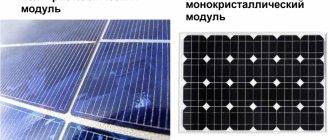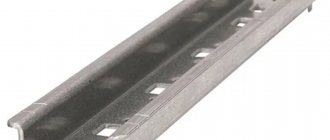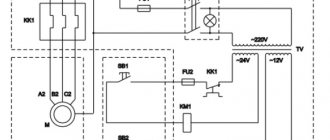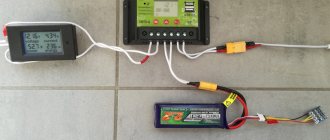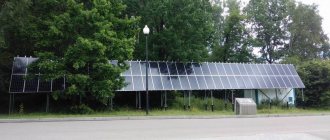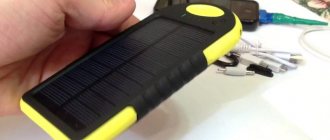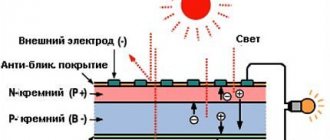When choosing a solar charge controller, most people wonder how to choose a solar charge controller.
The choice of solar charge controller should be divided into several aspects:
- Selection of solar panel array power;
- Selection by voltage of solar panels and batteries used;
- Selection based on maximum load or battery charging current, number of batteries;
- Selection by battery type;
- Selection according to required functions;
- Selection by type of voltage regulation and conversion;
- Selection by cost;
- Manufacturer's choice.
Product categories
- EPSolar solar charge controllers MPPT (1)
- Goal Zero Folding Solar Panels (2)
- Li-ion UPS and battery (8)
- MPPT Charge Controllers (40) Delta solar charge controllers MPPT (5)
- EPSolar solar charge controllers MPPT (20)
- I-Panda Solar Charge Controllers MPPT (3)
- JUTA solar charge controllers MPPT (3)
- Schneider Electric solar charge controllers MPPT (2)
- SRNE solar charge controllers MPPT (7)
- Stark Country INV (4)
- Chilwee batteries (30) DZM series (10)
- Series A (8)
- Carbon CDG Series (4)
- FT Series (10)
- Series MM (13)
- OP Series (8)
- GL Series (4)
- GPL Series (7)
- GST Series (3)
- VOSTOK PRO Series CK (15)
- Active charge equalizers (3)
- Ecovolt series Solar battery inverters (3)
- Boilers "Drazice" with enamel coating (4)
- BRAUDER hybrid inverters (1)
- Sets of autonomous two-way traffic lights T 7.1 (38)
- Autonomous solar power plants (6)
- AcmePower inverters (14)
- AcmePower inverters (7)
- AcmePower UPS (8)
- MPPT Charge Controllers (2)
- Delta BST Monocrystalline Solar Panels (9)
- Delta BST Polycrystalline Solar Panels (6)
- Size II (4)
- IP65 Weatherproof Electrical Box for Pole and Wall Mounting (1)
- GoodWe grid inverters (3)
- LED light bar (1)
- Boilers and buffer tanks (2)
- Flexible solar panels (2)
- EcoFlow Folding Solar Panels (1)
- Infrared gas heater Ballu BIGH (6)
- Delta solar charge controllers "PWM" (8)
- Inverters Energy UPS PRO (7)
Selecting a controller by battery type
Different types of batteries must be charged using different charging programs. This is due to the different chemical composition of batteries. Charging programs have different charging algorithms. In accordance with the selected battery charging program, the charge controller regulates the voltage and current within the set range. Modern controllers charge controllers using pulse width modulation technology, such controllers are called PWM (PWM) controllers. Moreover, more expensive controllers, called MPPT, which use technology to find the point of maximum power from an array of solar panels, also charge batteries using PWM technology. First, the MPPT controller selects maximum power, and then, using a PWM converter, charges the battery in accordance with the established charging program.
Depending on the available batteries, you need to select a controller that has a charging program specifically for your type of battery. Let's look at the main types of batteries and their charging conditions:
1) Lead-acid with liquid electrolyte. They are usually charged with a voltage no higher than 14-15 volts, it can be higher up to 17 volts, but the electrolyte will quickly boil and the process of boiling away and destruction of the plates will begin, so you will have to continuously monitor the charging process and when bubbles begin to form, still lower the voltage to 14 volts , or turn off the charge and let the battery cool. Also, such batteries emit explosive gas when charged, so they must be charged with the valves open and in a well-ventilated area.
2) Lead-acid sealed with thickened or absorbed electrolyte. These are batteries made using GEL and AGM technology. These batteries must be charged with a voltage no higher than 14 volts. This is due to the fact that if the process of heating the thickened or absorbed electrolyte begins, the structure of the electrolyte will begin to collapse and lose its properties, and unlike liquid acid ones, the electrolyte cannot be changed or restored.
3) Alkaline batteries. They require a charge voltage of 10V to 17V; you need to monitor the charging process.
4) Nickel
5) Lithium, have a special charge control unit.
Simple charge controllers have one or two charging programs for lead-acid batteries, for unsealed liquid batteries and for sealed GEL or AGM batteries.
Backup power supply kit 2000W inverter power, 5.2 kWh energy reserve
0 less than 5
(0)
Article: R-01
₽108,900.00 Add to cart
Add to favorites
Compare
Selection of solar array power by power
The main parameter of a solar charge controller is the operating voltage and the maximum current with which the charge controller can operate. It is very important to know such parameters of solar panels as:
- Rated voltage – operating voltage of the solar panel circuit closed to the load, i.e. to the controller;
- Open Loop Voltage – The maximum achievable solar loop voltage when not connected to a load. This voltage is also called open circuit voltage. When connected to a solar controller, the controller must be able to withstand this voltage.
- Maximum input current from solar panels, solar circuit current in short circuit mode. This parameter is rarely indicated in the controller characteristics. To do this, you need to find out the fuse rating in the controller and calculate the short-circuit current of the solar modules in the circuit. For solar panels, the short circuit current is usually always specified. The short circuit current is always higher than the maximum operating current.
- Rated operating current. The connected solar circuit current that is produced by the solar cells under normal operating conditions. This current is usually lower than the specified current in the characteristics for the controller, since manufacturers, as always, indicate the maximum current of the controller.
- Rated power of connected solar panels. This power represents the product of the operating voltage and the operating current of the solar panels. The power of solar panels connected to the controller must be equal to the specified or less, but not more. If the power is exceeded, the controller may burn out if there are no fuses. Although most controllers, naturally, have fuses designed for an overload of 10-20% for 5-10 minutes.
EP3200 3500-24 LCD screen pure sine with charger
0 less than 5
(0)
Article: EP3200-3500-24
₽33,440.00 Add to cart
Add to favorites
Compare
Selection of controller based on maximum load, battery charging current and number of batteries
One of the important aspects of choosing a controller is the maximum output power of the controller, which must be taken into account both from the controller and from the battery. Let's look at why.
Let's say we have a set of high-capacity batteries. Accordingly, in order to charge these batteries during the day, the controller must produce the necessary power, and the power of the connected solar panels must, of course, be no less. If the power of the controller and the array of solar panels is less, then the batteries will not have time to charge during the day, and under constant load they will be discharged even more, and so on each time, which will affect their subsequent resource.
If the batteries connected to the solar controller have a small capacity. For modern controllers, this problem is no longer relevant, but it is worth considering this option. On old or simple controllers, it was very important to choose a controller whose power with equal power from solar panels will allow you to charge a battery discharged overnight during the day and provide power to daytime electrical loads. For rechargeable batteries, the maximum charging current should not exceed 30% of the nominal capacity; if the battery has a capacity of 100Ah, then the charging current should not exceed 30 Amperes. If the power of the solar system were excessive, then the controller would continue to charge the battery even after they were fully charged, without lowering the charging current and voltage, which led to the electrolyte boiling, boiling, boiling and damage to the battery. Modern controllers have a built-in computer that monitors battery parameters, has a charging program, controlled shutdown relays, and can also regulate the charging current and voltage.
Solar single-phase network inverter Sofar 4.6KTLM-G2 4600VA (2 MPPT)
0 less than 5
(0)
Article: 4.6KTLM-G2
₽43,428.00 Add to cart
Add to favorites
Compare
Selecting a charge controller according to the required functions
In the modern world, in an effort to increase the efficiency, autonomy and efficiency of information control, solar charge controllers are also subject to requirements for providing various functions, depending on the location of the controller.
The most popular functions required in a charge controller are:
- Auto-determination of the nominal voltage of solar panels and batteries 12V/24V/36V/48V, etc.
- Availability of a display for displaying readings and ease of setup;
- Ability to manually set controller operating parameters;
- Availability of communication ports for connecting an external display or computer, allowing for remote access. Ports such as RS232, USB, Ethernet interfaces for communication with other devices;
- Supports various types of batteries;
- Built-in protection: overload, overcharge, short circuit;
- Comprehensive self-diagnosis and electronic protection can prevent damage from improper installation or system errors;
- External temperature, current, etc. sensors;
- Relay for controlling other devices;
- Built-in timers for load shedding;
- Electronic log of controller operating parameters.
The solar charge controller must be selected based on the required functions.
6. Selecting a controller based on the type of voltage and current regulation. PWM and MPPT.
Based on current and voltage regulation, modern controllers can be divided into two main types: PWM and MPPT.
1) PWM controllers.
2) MPPT controllers.
A detailed description of the technology is best viewed in the articles PWM controllers, MPPT controllers, what is the difference between PWM and MPPT controllers.
What it is
The charge controller is one of the electronic devices in the control circuit of solar power plants.
The device monitors the battery charging parameters and regulates the charging process.
The device performs the following functions:
- Turns off the battery when it reaches full charge;
- Disconnects consumers when the charge drops to minimum values;
- Reconnects consumers in case of charge restoration;
- Controls the progress of the charging process;
- Automatically connects energy sources to charge energy storage devices.
The use of controllers allows you to extend the service life of batteries and automate the operation of power plants.
For automatic and safe operation, the devices are equipped with various modes in which they are able to operate in accordance with the specified parameters, and are also equipped with means and protection elements.
These elements include:
- From incorrect polarity on the current source and on the load;
- From short circuits on incoming and outgoing lines;
- From various types of overheating and high voltages.
How to choose and where to purchase converters?
It will be cheaper to purchase photocells on Chinese Internet sites, although, of course, they often sell defective factory parts. For a start, this is not bad, especially since their price is lower. And after you gain experience in assembling batteries, you can take higher quality parts from the factory.
Some sellers sell converters all en masse sealed in wax so that they are not damaged during transportation, because silicon wafers are fragile, like crystal. Cleaning them of wax is a very labor-intensive task.
First you need to immerse them in hot water and after the wax melts, very carefully separate them
You need to choose not only for the reasons that you liked this particular product - you must definitely pay attention to the reviews and rating of the seller. If you don’t want to pay twice as much for an item due to paid shipping, you need to see if the selected item has a “free shipping” option. If not, this is not a suitable option, since it is too costly.
If not, this is not a suitable option, since it is too costly.
Money for the goods must be transferred immediately. They will be sent to the seller only after confirmation of receipt of the goods by the buyer. You can pay directly with a payment card or through intermediate services - it all depends on the degree of trust in such online trading resources. You can also return the product, but it is better to immediately purchase from a seller with a good reputation in order to avoid litigation regarding the return. The parcel can take a month or a month and a half - this is already at the mercy of the post office.
Selection by cost
An important criterion for choosing a controller is the cost of the controller. When the question arises, which controller to buy, more expensive or cheaper, in the case of small solar power plants, a decision arises: it is easier and cheaper to buy a controller, and use the difference in price to buy another two solar panels.
If you want to install a simple autonomous solar power plant, then you should choose an inexpensive but high-quality PWM controller with a power reserve of 20-30%.
If you are very critical about the installation of a power plant, all the parameters of the station are important to you, high efficiency, parameter control, remote control capabilities, as well as switching between the power plant and the power grid, or automatic switching on of the generator, then it is worth purchasing an advanced, modern MPPT controller, with many functions, built-in protections, the ability to control external devices and redistribute loads.
Connection diagram
The energy generated by solar panels does not have the technical ability to be directly used to operate any electrical appliances. To allocate the voltage necessary for operation, unique inverters are used, located between the panel and the main consumption network.
In this case, you need to know the three main types of solar panel connections.
Offline connection. This option is most often used in those territorial areas where there is no centralized power supply network. In this case, the structure is formed by high-power rechargeable batteries. The principle of their operation is to accumulate energy within themselves during daylight hours. When the time comes for insufficient lighting, the accumulated flows are redirected to the network.
- Backup connection. This method is optimal in places where there is a centralized power supply via an alternating current network. The creation of a backup energy generation system in this case is used as a backup option, the need for which may arise in case of emergency situations. Power outages are far from uncommon in summer cottages and suburban farms and areas, so many homeowners create additional opportunities to obtain heat and light.
- Serial network connection. To connect the system to the grid, this method involves generating excess solar energy and then feeding it into the grid for eventual sale.
Operating rules
Battery manufacturers always note the fact that the reliability and durability of such devices depends on operating conditions. There are several simple recommendations that can help you significantly extend the life of your purchased battery:
- Room ventilation. There is simply no single rule in this case, since everything depends on the situation. If the user uses a standard battery, the capacity of which corresponds to the solar panel battery, then there is simply no need to create additional ventilation conditions. In addition, the battery emits a small amount of gases that destroy fungi, mold and bacteria that are dangerous to humans. Such gases are completely harmless to animals and people, so you don’t have to worry about poisoning.
- Optimal temperature conditions. Those who have been using batteries for solar panels for several years now know that such devices work best at temperatures from +5 to +15˚С. The main thing is to avoid sudden temperature changes, which can damage the entire system. In this regard, it is better to install batteries in spacious cellars and basements.
- Battery capacity. If there is such an opportunity, then it is better to give your preference to devices with large capacity. This is due to the fact that the user will be able to connect powerful electrical devices that consume large amounts of current. Because of this, there is often a serious sag in the voltage in the battery, which can lead to a complete shutdown of the battery. If the user purchases a battery with a minimum capacity, this may not be enough for stable operation of the angle grinder and screwdriver.
- Battery charge for solar panels. During their operation, powerful batteries produce a fairly large amount of gases that need to be effectively eliminated. It is worth noting that some manufacturers have equipped their products with special holes for ventilation, which are located at the end. In this case, the situation is greatly simplified, since the user needs to connect a small silicone tube and take it outside. If desired, you can use a regular tube from medical droppers.
It is also worth considering that purchasing a large-capacity battery is considered more expedient, since in this case the user receives many advantages: the charging and discharging processes will occur in the most gentle current mode.

